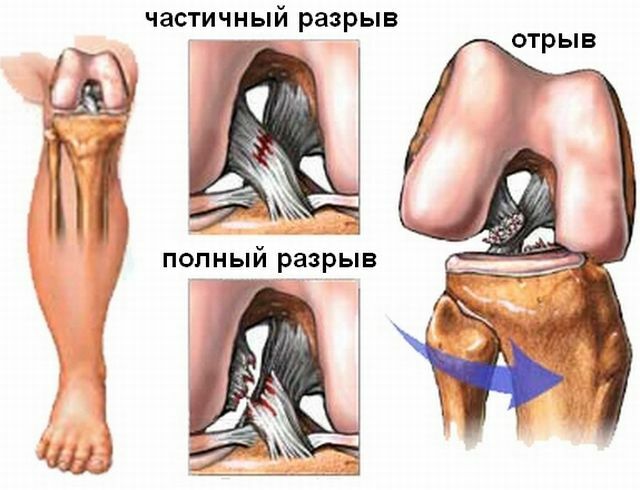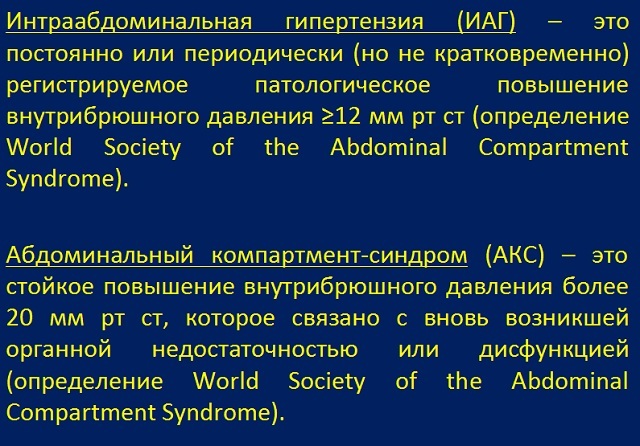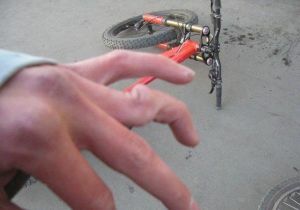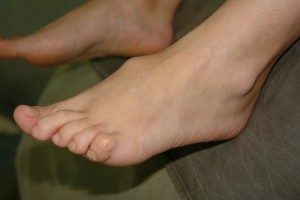 One of the common types of injuries of the bones of the lower limbs is a fracture of the ankle. Experts argue that the most difficult and dangerous injury is a fracture of the talus bone of the foot.
One of the common types of injuries of the bones of the lower limbs is a fracture of the ankle. Experts argue that the most difficult and dangerous injury is a fracture of the talus bone of the foot.
This is due to the fact that the talus bone plays an important role in the joints of the foot, and the fracture itself can cause many complications.
Content
- article Anatomically
- Symptoms injury
- Examinations
- Features of treatment
- Recovery
- injury Possible consequences
Anatomically
fracture of the talus is rarely diagnosed, but it is quite serious damage. The location of the location of the talus is the area between:
- calcaneal;
- tibia;
- and fibula.
Its dimensions are small and no muscle is attached to the talus, but it is important for the normal operation of the entire foot. It is possible to highlight some features of the structure of bone:
- is it accounted for the largest load all body and a sharp increase in the voltage can be disrupted its integrity;
- most of the bone covers the cartilage of and its fracture causes limitation of joint mobility, as well as problems with foot mobility;
- talus characterized by poor blood supply and this provokes a slow accretion of debris after the injury and can lead to necrosis of the bone fragments.
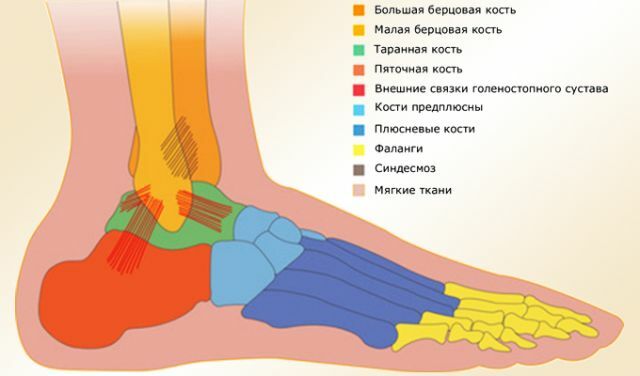
It is known from the course of school biology that the talus bone has:
- body;
- head;
- neck;
- posterior process.
Specialists claim that the neck and body are most often affected, and the damage to the process of the talus is relatively rarely diagnosed.
Fracture may occur for the following reasons:
- falling from a high altitude or performing a jump on the heel;
- rear bending with simultaneous turning of the foot;
- intensive back folding of the foot.
Predominantly, the fracture of the talus is diagnosed as an unsuccessful result of sports and traffic accidents. Symptoms
trauma injury usually accompanied by the appearance of characteristic symptoms:
- One of the main signs of fracture considered formation of a strong swelling of the soft tissues in the affected area .
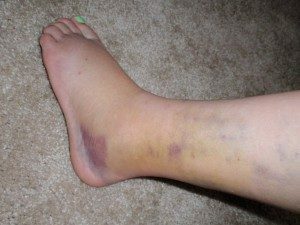 Most often, the localization of the edema becomes the back surface of the foot and a strong increase in its size is observed.
Most often, the localization of the edema becomes the back surface of the foot and a strong increase in its size is observed. - There are severe pains of , and the area of their ankle becomes the area of the ankle joint. In view of which section of the bone is damaged, the site of the localization of pain can be either the front or the back of the foot. When you try to move your thumb, there is an increase in pain.
- Trauma of the talus causes problems with the functioning of the foot. At the slightest attempt to lean on the lower extremity, there is a strong pain in the ankle, which makes its movement impossible.
- Deformation of is observed due to swelling of the tissues and often it is the result of fracture of the talus with displacement.
In the event that a patient is diagnosed boundary fracture of the talus, it causes minor pain and violation of traffic volume slightly pronounced.
Many patients do not rush to seek help from a specialist and take a fracture for a normal injury. Lack of effective treatment leads to the fact that the fracture becomes chronic and this significantly prolongs the recovery period of the patient.
Examinations
For accurate diagnosis expert examination of the patient is carried out using the following methods: 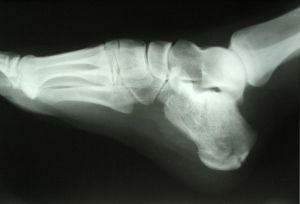
- radiography allows you to obtain a complete image of the foot and assess the severity of the injury;
- computed tomography provides information on the degree of bias and helps to select the subsequent treatment tactics;
- MRI allows to determine avascular necrosis and osteochondral trauma of the dome of the foot.
Features of treatment
The choice of this or that method of treatment for fracture of the talus is determined by the degree and area of the lesion. Elimination of pathology can be performed using the following methods:
- conservative therapy;
- surgical intervention.
 In the event that the injured person does not have a displacement, a plaster bandage is established from the toes to the upper third of the shin.
In the event that the injured person does not have a displacement, a plaster bandage is established from the toes to the upper third of the shin.
This bandage should be worn for several weeks, after which it is removed and the patient can be subjected to a small load of the foot. With successful treatment, after three months, the patient is allowed to subject the leg to normal loads.
A more complex variant of the fracture is a trauma with displacement of debris. To treat such an injury, removal of the debris displacement is appointed, that is, repositioning is performed.
This procedure is accompanied by the appearance of severe pain, so it is performed with the use of anesthesia. The treatment of the trauma in this situation is carried out according to the following scheme:
- , the foot is stretched out in length, after which its sharp bending is performed;
- , when the desired result is achieved, fixation is performed with a plaster boot, and its arch should be correctly modeled;
- after 7 weeks, the plaster bandage is changed and the foot is placed at a right angle;
- usually in the treatment of such pathology a rigid fixation of the foot is necessary for several months.
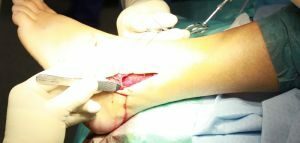
Open repositioning of
In case of a severe fracture, when it is impossible to fold the fragments of the talus bone by a closed method, an open reposition is used. Such treatment involves the fixation of debris with the help of Kirschner's spokes, and an X-ray photograph is always taken to check the correctness of the spokes.
If the patient is diagnosed with complete bone destruction or her necrosis, then arthrodesis is prescribed.
When performing this procedure, the adjacent bones that form the joint are bonded. In the future, the absence of any functioning of the joint is diagnosed and there are no movements in it.
When carrying out a surgical intervention, an immobilizing dressing is necessarily applied, except for the application of a rod apparatus, which can fix the limb itself.
Recovery after injury
After the fracture, rehabilitation measures are carried out and their main goal is:
- restoration of mobility in the ankle joint;
- return of normal functioning of the limb.
Rehabilitation of the patient is performed using the following procedures:
- therapeutic massage;
- physiotherapy procedures;
- therapeutic exercise, which involves a gradual increase in the load on the foot;
- ozokeritotherapy;
- paraffin treatment.
Carrying out these procedures helps to speed up the restoration of the functioning of the affected joint and return the patient to the usual life.
Possible consequences of
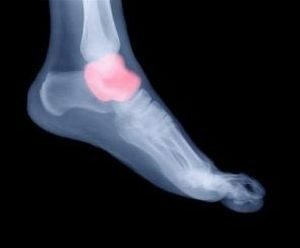 As a result of fracture of the talus, tissue necrosis may develop. This pathology is accompanied by a strong swelling of the soft tissues and the appearance of strong pain, which leads to a change in the quality of life of the patient.
As a result of fracture of the talus, tissue necrosis may develop. This pathology is accompanied by a strong swelling of the soft tissues and the appearance of strong pain, which leads to a change in the quality of life of the patient.
Most often necrosis develops in the event that a fracture of the talus caused damage to blood vessels or the infection penetrated into the resulting wound.
Another serious consequence after the fracture of the talus is the appearance of problems with the correct work of the ankle joint.
In the event that it was possible to diagnose a complication at an early stage of its development, the chances of a full recovery of the patient are increased.
In the event that it was not possible to prevent damage to the talus, it is necessary to try to avoid the development of unpleasant consequences. It is important to follow the prescribing doctor's instructions and take care of yourself throughout the rehabilitation period.

